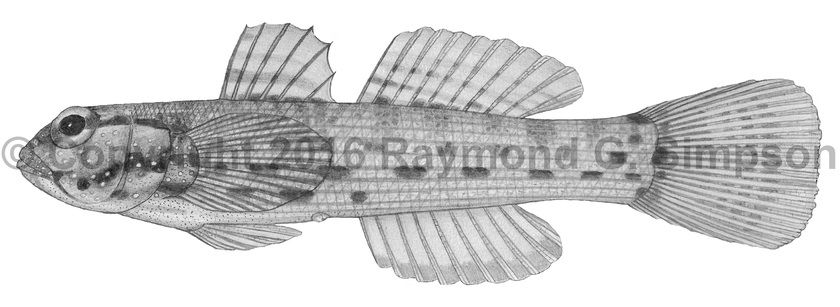
Common Name
Antilles Frillfin Goby
Year Described
Tornabene, Baldwin, & Pezold, 2010
Identification
Dorsal Fin: VI, 10
Anal Fin: I, 8
Pectoral Fin: 18-21
Caudal Rays: 17 upper, 15 lower lobe (all types)
Scale Rows: 38-42
Pre-dorsal Scales: 18-21
Body of typical shape for the gobies but robust. Eye medium sized; about equal to snout length. Upper jaw usually more than 11% of SL. Pectoral fin extends to rear margin of first dorsal. Upper pectoral rays separate from membrane; bifurcate or multifurcated. Pelvic fins fully fused into disk. Pelvic fins do not reach anus. Caudal fin rounded. Body fully scaled with scales extending forward to level of pre-opercular margin.
Color
Body pale with numerous thin parallel lines on body which are about the same width as interspaces. There are several rows of dark blotches with the markings becoming more irregular and diffuse on the dorsum. The lower body blotches are most distinctive: a complete row of 7-8 blotches running from the trunk to tail and a partial row on the belly of 3-4 blotches that fades at anal fin origin. Caudal peduncle with strong but separated spots. Head with dark stripes and blotches and smaller pale spots. Two dark stripes on lower head continue to base of pectoral fin. Spiny dorsal fin with basal spots, a continuous dark stripe above that, and a pale yellow distal area. Soft dorsal fin with lines of dark spots basally and a broad yellowish border. Caudal fin with banding and spotting on the median segmented rays fading on the lobes to pale yellowish. Anal fin pale with a dark border and base. Pelvic and pectoral fins pale yellow
Size
Maximum size to 75mm SL.
Habitat
Insular reefs where it is found in shallow waters and intertidal areas around rock and reef rubble.
Range
Widespread at island localities in the Caribbean Sea from the Florida Keys to northern Venezuela. Occurs off Central America but mainly at offshore islands and atolls. Records from Brazil are likely an undescribed species (see notes).
References
Lima-Filho, P.A., R. de Souza Rosa, A.D.S. de Souza, G.W.W.F. da Costa, C. de Oliveira, & W.F. Molina. 2016. Evolutionary diversification of Western Atlantic Bathygobius species based on cytogenetic, morphologic and DNA barcode data. Reviews in Fish Biology and Fisheries: 26(1), 109-121.
Tornabene, L., C. Baldwin, L.A. Weigt, and F. Pezold. 2010. Exploring the diversity of western Atlantic Bathygobius (Teleostei: Gobiidae) with cytochrome c oxidase-I, with descriptions of two new species. Aqua: 16(4), 141-170.
Tornabene, L. and F. Pezold. 2011. Phylogenetic analysis of Western Atlantic Bathygobius (Teleostei: Gobiidae). Zootaxa: 3042, 27-36.
Other Notes
Closest morphologically to the high count and longer-jawed Bathygobius lacertus and B. soporator but falls out in a completely different clade with B. curacao and East Pacific B. ramosus (Tornabene & Pezold, 2011). Distinguished from the former clade using color pattern, especially the two lower blotch rows and dorsal fin pigmentation (Tornabene et al., 2010).
A Brazilian lineage of Bathygobius studied in Lima-Filho et al. (2016) as Bathygobius sp.2 was identified as the sister to the Caribbean populations of B. antilliensis. This population is restricted to Brazilian oceanic islands and given the genetic divergence is probably an undescribed species allied to B. antilliensis.